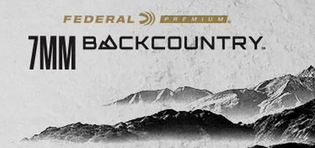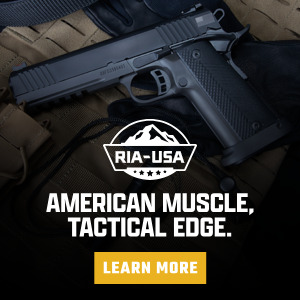
Shot Show offers new insights and releases never before seen to the public. It’s a chance to take a look at the ongoing development and change that can and may impact shooters across the world. This is where innovation and ideas meet production. One such release this year was the development of the 7mm Backcountry (BC).
Federal’s announcement of the 7mm Backcountry was met with both curiosity and skepticism which left many people asking, “Why?” That’s common with any new rifle caliber, but the Backcountry takes an interesting twist that many didn’t see coming. Because of the changes and development within the cartridge itself, it’s begun to explore unique materials and tolerances never before seen in a production caliber stateside.
What is the 7mm Backcountry?
Announced on January 7th, 2025, the 7mm Backcountry is, at its core, a highly packed steel case ammunition designed for long range hunting capabilities. It’s made from a ‘Peak Alloy’ material which is some kind of alloyed steel capable of withstanding significant pressures. The goal has been to produce magnum velocities in a smaller action without compromising ballistics or efficiency.

For comparison, a 7mm BC produces roughly 3150 fps from a 24-inch barrel with a 170-grain projectile. 7mm PRC produces 3000 fps with the same projectile. Federal boasts that in a 20-inch barrel velocities would measure 3000 fps and 2850 fps with 7mm BC taking the lead. Many view this increase as an optimal ‘all-range’ hunting caliber.
What about problems?
Well, the 7mm BC does have significant drawbacks on paper. For the gains achieved there must absolutely be some drawbacks. The greatest of those being the case material making reloading difficult and cases extremely rare. Another being that any velocity gain is going to translate into more forced recoil. It’s just physics.

That said, the 7mm BC does provide benefits with velocities while staying a hair longer than the 7mm Rem Mag. When I say a hair, it’s in the hundredths of an inch longer so standard long actions are well suited for the caliber without requiring magnum actions. The big question is, what actions can handle the pressure?
Without load data available, it’s hard to know exactly how much powder is incorporated into the 7mm BC. Based on images and cutaways, it’s safe to assume compressed loads may be part of the integral design and gains. This can mean even minor issues with loadings can produce significant catastrophic events. There is no room for any error and all shooters know that even factory loaded rounds are not error free.
With the design specs of the 7mm BC, pressure appears to be the greatest deterrent. At 80,000 PSI, the 7mm BC far exceeds the 30/06 58,740 PSI, 7mm Rem Mag 61,000 PSI, and 7mm RUNM 65,000 psi. It would appear that the actions required to run the 7mm BC need some reinforcement. The caliber may not put out that high of a pressure with factory loads, but the steel alloy case is designed for 80,000 PSI so it’s not a stretch to think the full capabilities of the new caliber are only fulfilled at higher pressures. Federal does market the caliber to be loaded to maximum chamber pressures to achieve the 3,000 fps.
For the reloader?
Without load data available, it’s hard to say exactly what the reloading requirements are. There are rumblings that RCBS is testing out die manufacturing for the 7mm BC. This has some serious consequences based on the case materials alone. Steel, is near impossible to reload efficiently multiple times and puts a lot of stress on the dies used. It can be done, but not the standard practice. Steel can be annealed to be as soft as brass, but will harden much faster and will wear on the internal components of a firearm much faster than a brass counterpart. While some firearms are made and designed to run steel cased ammunition, like the AKM, it’s still not a perfect solution for inexpensive material alternatives. While Federal does say their internal tests do not show excessive or abnormal wear, this hasn’t been proven independently at the time of writing this article.
As I’ve said before, there is no reload data available. We don’t know what powders will work, the charge level, what 3rd party projectiles will provide decent ballistics, or even if it’s a compressed load! Any reloader will tell you that compressed loads are generally avoided as the pressure spikes can be deadly. That’s not to say it can’t be done, but it’s not proven for the handloader. There are still a lot of questions to be answered but Federal has stated the cases are reloadable, even if they might require specialized tools.
Let’s look at some benefits:
Federal has designed this cartridge to handle magnum needs in a standard long-action receiver. I should note that internal dimensions between magnum and long actions are generally the same, but the bolt face and extractor, and in some cases the rails, may be quite different. 7mm BC uses a standard 30/06 bolt face dimension making conversions an easy barrel swap. This also means that more rounds can be carried compared to the magnum loads with relatively similar velocities.

With velocities possible on ‘shorter’ barrels of 20-inches, the 7mm BC can easily be suppressed and carried by hunters without excessive length addition. I won’t get into the specifics of suppressing shorter barrels, but it’s a marginal benefit.
The case, built with Peak Alloy Technology, does provide a lot of protection for the shooter. Will it rust? Yes. Federal has plated their cases with nickel plating to prevent that from happening but nothing will stop it. The casing material alloy is different than conventional steel case options that have been available for nearly a century.
Felt recoil is also addressed by the company that says the felt recoil is not different than that of a 7mm Rem Mag. I, for one, find this hard to believe but having no experience with the 7mm BC means I am making this statement out of ignorance and not experience. 7mm Rem Mag is also a pretty stout caliber and produces more recoil than many feel is necessary. While it doesn’t increase recoil, according to the manufacturer, it doesn’t mitigate any from comparable calibers that are more common.
What’s the Outcome?
Federal’s 7mm Backcountry is an exciting caliber. While it promises a lot, the new development of the case means information and experience is both limited and confusing. If the 7mm BC does prove itself during the initial production, it may open the door for a lot of caliber conversions.
With the ability to achieve high velocity in a short(er) barrel, 7mm BC does lend itself to all sorts of shooting positions and distances. While it’s far from perfect, the options available to it make up for a lot of potential shortcomings. The only real question left to answer is; How much will it cost to get involved?








